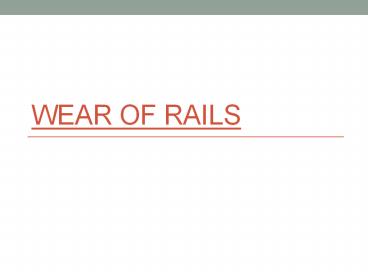WEAR OF RAILS - PowerPoint PPT Presentation
Title:
WEAR OF RAILS
Description:
Screening . Screening is the first operation at any wastewater treatment works. This process essentially involves the removal of large non-biodegradable and floating ... – PowerPoint PPT presentation
Number of Views:138
Avg rating:3.0/5.0
Title: WEAR OF RAILS
1
WEAR OF RAILS
2
TYPES
- Wear on head of rail
- Wear on ends of rail
- Wear of rail on curve
3
WEAR ON HEAD OF RAIL
- Wear on head of rail is due to abrasion on moving
rails. - Due to grinding action of sand or dust between
the rails and wheels of the train.
4
Cont
- When train starts or applies brakes, the wheel
just slides on the rails causing wear on the
head. - Load coming on to a track may exceed the carrying
capacity of the section. Thus causing the wear in
the head of rail.
5
WEAR AT THE ENDS OF THE RAIL
- It is much greater than the wear on the head of
the rail. - This type of the wear is resulted due to the
blows which the rail receive when the wheel jumps
the space between the rail ends. - The ends are battered by such blows.
- The contact surface between the sleepers and the
rail is worn as the as the effect of these blows
increased.
6
CONT
- The ballast under the sleepers will loosen due to
increase in the intensity of vibrations, also the
sleeper will depressed due the displacement of
ballast, also the fish plates will get loose
under the constant impact of increasing vibrations
7
WEAR OF RAIL ON CURVE
- On the curve the wear of the rail takes place in
both inner and outer rails. - On the curve the, the outer wheel has to move
through greater distance than the inner wheel.
And the inner wheel has to slide over the inner
rail.
Curved Crossing
8
CONT
Wheel
- As a result of this sliding wear of the inner
rail occur because the metal in the rail head is
burnt. - At the curve, flange of outer wheel will strike
the inner surface of the outer wheel due to
centrifugal force. Thus side of the head of rail
wears out.
Slope 120
Flange of Wheel
9
TYPES OF CROSSING
10
TYPES OF CROSSING
- Square Crossing
- Diamond Crossing
- Cross Over
- Scissor Crossing
- Symmetrical Split
11
SQUARE CROSSING
- When to railway lines cross each other at 90o it
is called Square Crossing
12
(No Transcript)
13
DIAMOND CROSSING
- Angle of intersection (crossing angle) of two
tracks is when not 900 , then crossing is called
diamond crossing.
14
(No Transcript)
15
CROSS OVER
- A cross over is introduced to transfer a train
from one track to another track which may or may
not be parallel to each other
16
(No Transcript)
17
SCISSOR CROSSING
- If two cross overs are required between two
parallel tracks and there is no sufficient space
for crossing to be kept separate, then they are
made to over-lap each other and result is a
scissor crossing.
18
(No Transcript)
19
SYMMETRICAL SPLIT
- If radius of main track is equal to the radius of
turn out curve, then the turn out is known as
symmetrical split.
20
CREEP OF RAILS
21
CREEP OF RAILS
- Definition
- It is a horizontal movement of rails in a track.
It can be minimized but cannot be stopped.
22
Causes of creep
- The causes of creep in rail can be broadly
classified into two categories - 1. Major causes of creep
- 2. Minor causes of creep
23
Major causes of creep
- 1. Creep may be developed due to forces that come
in operation when the train is starting or
stopping by application of brakes. - Increase of starting the wheel pushes the rail
backward and hence the direction of creep is in
backward direction.
24
- When brakes are applied then wheels of the
vehicles push the rails in forward direction and
hence the creep is in forward direction.
25
- 2. Creep is also developed due to wave motions.
When train passes on a track, the portion of rail
length under the wheel of train will under more
stresses and little depression will exist. - As a result, this depression will cause (set) a
wave motion in the rail or track
26
- 3. Another reason creep develops because of
unequal expansion and contraction owing to change
in temperature.
27
Minor causes of creep
- Rails not properly fixed to sleepers.
- Bad drainage of ballast.
- Bad quality of sleepers used.
- Improper consolidation of formation bed.
- Incorrect allowance for rail expansion.
- Rail joints maintained in bad conditions.
- Rails fixed too tight to carry the traffic.
28
Direction Of Creep
- Alignment Of Track
- Creep is more on curve track than on a tangent
portion (straight track). - Direction of movement of trains
- Creep will be more in the direction to which the
loaded train moves more.
29
Extent Of Creep
- Creep does not vary at some constant rate. (it is
not constant) - Creep does not continue in one direction only.
- Creep for two rails of the track will not be in
equal amount.
30
Result Of Creep
- Expansion gap is reduced, buckling of track take
place. - Sleepers are moved out of a square.
- Crossing points get disturbed.
31
Square Position of Sleeper
Sleeper out of square































